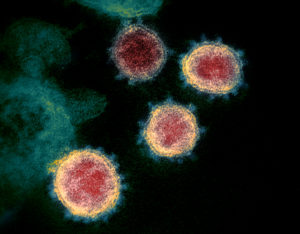 A new study conducted at the University of Maryland has depressing results for those of us concerned about the contagiousness of the flu (influenza) virus. According to the study, the flu virus is transmitted much easier than thought - don't need to cough or sneeze to spread it. Just breathing will do it.
A new study conducted at the University of Maryland has depressing results for those of us concerned about the contagiousness of the flu (influenza) virus. According to the study, the flu virus is transmitted much easier than thought - don't need to cough or sneeze to spread it. Just breathing will do it.
The researchers found that those with the flu can shed infectious virus in exhaled "aerosol particles small enough to remain suspended in air". That means they can spread the flu virus just by exhaling little flu particles into the air when they breathe. So stay home if you can to avoid giving the flu to others.
Another very interesting finding was that those who had been vaccinated that year and the prior year for the flu actually had "increased shedding" of the flu virus in their exhaled breath - that is, they had increased influenza virus "aerosol generation". Yikes! The researchers said that this finding, along with recent other studies suggesting "reduced protection with annual vaccination" means we may have to rethink influenza vaccination recommendations and policies. From Science Daily:
Flu may be spread just by breathing
It is easier to spread the influenza virus (flu) than previously thought, according to a new University of Maryland-led study released today. People commonly believe that they can catch the flu by exposure to droplets from an infected person's coughs or sneezes or by touching contaminated surfaces. But, new information about flu transmission reveals that we may pass the flu to others just by breathing. The study "Infectious virus in exhaled breath of symptomatic seasonal influenza cases from a college community," published in the Proceedings of the National Academy of Sciences, provides new evidence for the potential importance of airborne transmission because of the large quantities of infectious virus researchers found in the exhaled breath from people suffering from flu.
"We found that flu cases contaminated the air around them with infectious virus just by breathing, without coughing or sneezing," explained Dr. Milton, M.D., MPH, professor of environmental health in the University of Maryland School of Public Health and lead researcher of this study. "People with flu generate infectious aerosols (tiny droplets that stay suspended in the air for a long time) even when they are not coughing, and especially during the first days of illness. So when someone is coming down with influenza, they should go home and not remain in the workplace and infect others."
Dr. Milton and his research team captured and characterized influenza virus in exhaled breath from 142 confirmed cases of people with influenza during natural breathing, prompted speech, spontaneous coughing, and sneezing, and assessed the infectivity of naturally occurring influenza aerosols. The participants provided 218 nasopharyngeal swabs and 218 30-minute samples of exhaled breath, spontaneous coughing, and sneezing on the first, second, and third days after the onset of symptoms.
The analysis of the infectious virus recovered from these samples showed that a significant number of flu patients routinely shed infectious virus, not merely detectable RNA, into aerosol particles small enough to present a risk for airborne transmission. Surprisingly, 11 (48%) of the 23 fine aerosol samples acquired in the absence of coughing had detectable viral RNA and 8 of these 11 contained infectious virus, suggesting that coughing was not necessary for infectious aerosol generation in the fine aerosol droplets. In addition, the few sneezes observed were not associated with greater viral RNA copy numbers in either coarse or fine aerosols, suggesting that sneezing does not make an important contribution to influenza virus shedding in aerosols.
 A study looked at how long the new coronavirus (SARS-CoV-2) which causes COVID-19 lives on human skin. Researchers in Japan used human cadaver skin (because they didn't want to infect living humans) to compare influenza and the new coronavirus. They found that coronavirus lives up to 9 hours on undisturbed skin! And influenza A virus (a flu strain) less than 2 hours.
A study looked at how long the new coronavirus (SARS-CoV-2) which causes COVID-19 lives on human skin. Researchers in Japan used human cadaver skin (because they didn't want to infect living humans) to compare influenza and the new coronavirus. They found that coronavirus lives up to 9 hours on undisturbed skin! And influenza A virus (a flu strain) less than 2 hours.
 A
A  A big concern nowadays is why some children develop autism, specifically autism spectrum disorder (ASD). Autism spectrum disorder is considered a life-long neurodevelopmental disorder that is thought to affect 1 out of 68 American children. While the causes of ASD are unknown in most cases, some studies report an association (higher risk) between a pregnant woman's infections and fever during pregnancy and risk of ASD in the baby, while other studies don't find such an association. Some studies also looked at the
A big concern nowadays is why some children develop autism, specifically autism spectrum disorder (ASD). Autism spectrum disorder is considered a life-long neurodevelopmental disorder that is thought to affect 1 out of 68 American children. While the causes of ASD are unknown in most cases, some studies report an association (higher risk) between a pregnant woman's infections and fever during pregnancy and risk of ASD in the baby, while other studies don't find such an association. Some studies also looked at the